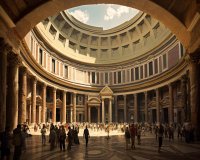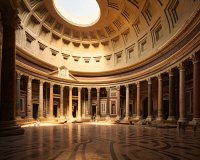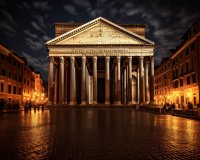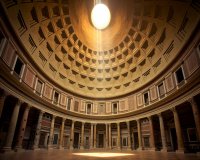The Pantheon’s Dome: An Engineering Wonder of the Ancient World
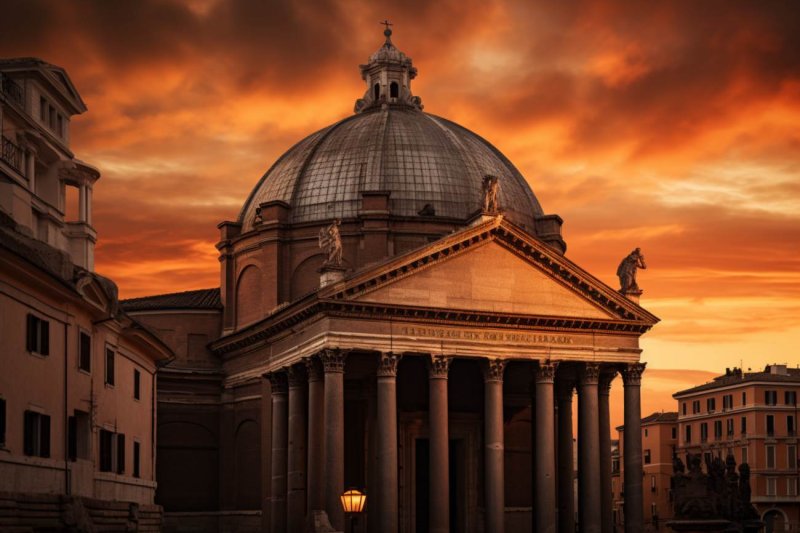
The Pantheon's Dome: An Engineering Wonder of the Ancient World
The Pantheon, located in the heart of Rome, stands as a testament to the incredible engineering prowess of the ancient world. This architectural marvel, renowned for its magnificent dome, has captivated the imagination of architects, engineers, and historians for centuries.
The Pantheon's dome, with its massive dimensions and perfect proportions, is a true engineering wonder. Constructed by the Romans in the 2nd century AD, this domed structure has defied the test of time, standing tall and proud as one of the most iconic landmarks in the world.
One of the most remarkable aspects of the Pantheon's dome is its construction technique. The dome is made of concrete, a material that the Romans perfected. The concrete dome of the Pantheon is unreinforced, relying solely on the ingenuity of its design and the quality of its materials. This ancient concrete dome is a testament to the advanced engineering skills of the Romans, who were able to create enduring structures without the aid of modern technology.
The interior of the Pantheon is equally awe-inspiring. As you step inside, you are greeted by the vast expanse of the dome overhead. The oculus, a circular opening at the top of the dome, allows sunlight to filter into the building, creating a mesmerizing play of light and shadow. The precision with which the oculus was positioned showcases the meticulous planning and expertise of the architects and engineers behind the Pantheon.
Furthermore, the Pantheon's dome has influenced countless architects and builders throughout history. Its architectural principles have been studied and emulated, serving as a source of inspiration for dome constructions in various cultures and eras. The dome's harmonious blend of form and function continues to be a topic of study in architectural schools worldwide.
Additionally, the Pantheon's dome has played a significant role in the development of architectural and engineering theories. Scholars have marveled at the mathematical precision of its dimensions and the innovative techniques used in its construction. The dome stands as a beacon of architectural excellence, reminding us of the incredible achievements of our predecessors.
In conclusion, the Pantheon's dome is a masterpiece of engineering, a symbol of ancient ingenuity, and a timeless inspiration for architects and engineers. Its enduring beauty and structural integrity serve as a testament to the brilliance of the ancient Roman builders. As we marvel at this architectural wonder, we are reminded of the limitless possibilities of human creativity and innovation.
Rome: Pantheon Skip-the-Line Entry and Guided Tour
Discover the breathtaking Pantheon in Rome on this guided tour. Take the stress out of your trip with skip-the-line entry, and get to spend more time learning about this historical building.
Begin by meeting your guide in the Piazza della Minerva next to the elephant statue. From there, listen to your guide give you a brief rundown of the Pantheon's history. Next, head over to the temple. Admire the building from the outside, marveling at its massive Corinthian columns and huge dome.
Head inside. Speed past the queues with skip-the-line entry. Immerse yourself in a combination of art, history, and spirituality. Admire the ceiling decorated with golden stars. If you like, pay your respects to famous figures such as Raphael, who rests there along with Italian kings and artists.
Meet your guide near the elephant statue at Piazza della Minerva. Our coordinator will be wearing a "Crown tours" t-shirt.
What to bring: Passport or ID card for children
Not allowed: Pets, Shorts, Weapons or sharp objects, Short skirts, Sleeveless shirts
Know before you go: The Pantheon is a church and requires modest clothing. This Guided tour is in English Only.
Customer reviews: The tour was exactly what I wanted. The meeting point was easy to find and the duration of the tour was perfect. The guide, Selenia, is really qualified and passionate about history and art and made the whole experience super delightful. I will recommend it without a shadow of a doubt.
The History of the Pantheon's Construction in Rome
The Pantheon in Rome is an iconic architectural masterpiece that has fascinated historians, architects, and visitors for centuries. Its construction is a testament to the engineering and architectural prowess of the ancient Romans. This article explores the history of the Pantheon's construction, highlighting its architectural features and the significance of this incredible structure.
The Pantheon, whose name means "Temple of all the Gods," was commissioned by Marcus Agrippa during the reign of Augustus in 27 BC. However, the current structure is not the original one. The first Pantheon was destroyed by fire in 80 AD, and the one we see today was built by Emperor Hadrian around 125 AD.
The Pantheon is renowned for its massive dome, which was a groundbreaking architectural achievement in its time. The dome of the Pantheon is considered one of the largest unreinforced concrete domes in the world. It spans a remarkable 43.3 meters (142 feet) and is the same distance from the floor to the oculus, the circular opening at the dome's top. The oculus is not only a unique design feature but also serves as the only source of natural light in the building.
The construction of the Pantheon's dome was a technical marvel. It consists of concrete made from a mix of volcanic ash, quicklime, and chunks of tufa. This concrete mixture was not only incredibly durable but also remarkably lightweight, allowing the massive dome to stand for over 2,000 years. The ingenuity of Roman engineering is evident in how they distributed the weight evenly, making the structure stable and enduring.
One of the most striking features of the Pantheon is its portico, which consists of a series of massive granite Corinthian columns. These columns were imported from Egypt, and their grandeur adds to the overall imposing effect of the structure. The inscription on the frieze of the portico still attributes the building to Agrippa, who was the original commissioner of the temple.
The interior of the Pantheon is equally impressive. The cylindrical interior space is vast and gives a sense of grandeur and openness. The oculus at the top of the dome not only provides natural light but also creates a captivating play of light and shadow throughout the day. This effect was used intentionally in the design to invoke a sense of the divine within the space.
Throughout its history, the Pantheon has served various purposes, including as a temple, a church, and even a tomb. In the 7th century, it was consecrated as a Christian church, ensuring its preservation through the Middle Ages. Today, it stands as a remarkable example of the continuity of Roman architectural heritage.
In conclusion, the Pantheon in Rome is a testament to the ingenuity and architectural brilliance of ancient Rome. Its construction, particularly the awe-inspiring dome and the use of innovative concrete, showcases the engineering prowess of the time. The Pantheon remains a symbol of Rome's enduring architectural legacy and continues to captivate visitors from around the world with its timeless beauty and historical significance.
Rome: Pantheon Official Audio Guide with Fast Track Ticket
Explore Rome's impressive Pantheon and enjoy insightful commentary from your audio guide. Learn about its fascinating history and how it was converted from a pagan temple to a Christian church.
Highlights:
- Unravel the history of the Pantheon on the official audio-guided tour
- Admire the revered temple and mausoleum of the Pantheon
- Marvel at the architectural features like the oculus of the huge dome
- Donate to the Basilica of Santa Maria ad Martyres by booking this tour
Make your way to the Pantheon to explore the best-preserved monument of ancient Rome. Collect your audio guide at the desk inside the Pantheon to begin learning about its fascinating history.
Constructed between 25 and 27 B.C., the Pantheon is the only ancient Roman building that has remained nearly intact through the centuries. Dedicated to all the gods of Pagan Rome, the temple was built by the Emperor Hadrian on the site of an earlier temple commissioned by Marcus Agrippa during the reign of Augustus.
Classified as a temple, the original use of the Pantheon and how people worshipped there is unknown as the structure is different from other traditional Roman temples, such as the Roman Forum.
Includes:
- Pantheon audio guide
- Pantheon skip-the-line entry ticket (if option selected)
- Donations to the Basilica of Santa Maria ad Martyres
Important Information:
- Access to the Basilica is only permitted to visitors wearing suitable attire (no shorts, vests, or sleeveless tops)
- A valid ID (passport, ID card, driver's license) or credit card will be required as a deposit in order to borrow the audio guide. Photocopies, pictures on the phone, student cards, and digital IDs aren't accepted
- The Pantheon is subject to anticipated closures, postponed openings, masses, concerts, or other events that may variate the service time
Customer Reviews:
Overall rating: 4.2/5 based on 7516 reviews
Review summary:
- Guide: 4.2/5
- Transportation: 2/5
- Service: 4.3/5
- Organization: 4.3/5
Experience the wonders of ancient Rome at the Pantheon. Book your official audio-guided tour and skip-the-line entry ticket today!
Engineering Techniques Used in the Creation of Rome
Rome, the eternal city, is a marvel of engineering and architectural achievement. From its impressive aqueducts to the majestic Colosseum, the city stands as a testament to the innovation and mastery of engineering techniques by ancient Romans. This article delves into some of the key engineering techniques employed in the creation of Rome.
Aqueducts: The Lifelines of Rome
The Roman aqueducts are iconic structures that played a vital role in the development and sustenance of the city. These engineering marvels were responsible for supplying fresh water to the growing population. The aqueducts utilized a combination of arches and tunnels to transport water from distant sources to the heart of the city. The famous Aqua Claudia, an aqueduct built during the 1st century CE, is a prime example of Roman engineering excellence, with its stone arches that span miles across the landscape.
Roman Roads: The Backbone of Empire
The Roman road system was another engineering feat that greatly contributed to the success of Rome. These roads were meticulously planned and constructed to facilitate rapid movement of troops, trade, and communication. Roman roads were made with carefully layered materials, including gravel and stone, to ensure durability and efficiency. The famous Roman road known as the Via Appia, or the Appian Way, showcases the quality of construction, with its well-preserved cobblestone surface.
The Colosseum: Monument to Precision
The Colosseum, one of Rome's most iconic landmarks, exemplifies the precision and innovation in Roman engineering. This grand amphitheater, capable of seating up to 80,000 spectators, was built using a complex system of arches, columns, and concrete. The concrete, known as Roman concrete, was a groundbreaking material that allowed for the construction of massive structures. The Colosseum's tiered seating and intricate network of tunnels beneath the arena were remarkable architectural innovations of the time.
The Pantheon: A Marvel of Dome Construction
The Pantheon, with its distinctive dome, is another engineering marvel that showcases the ingenuity of Roman builders. The dome of the Pantheon is an architectural wonder, and it remained the largest unreinforced concrete dome in the world for centuries. The engineering technique employed in creating this dome involved using lightweight concrete at the top and progressively denser materials as the structure descended, reducing the overall weight. This technique allowed the dome to stand for over two millennia.
Thermal Baths: Health and Hygiene
Rome was renowned for its thermal baths, where citizens could relax and enjoy the benefits of communal bathing. The construction of these baths incorporated advanced heating and plumbing systems. The Roman engineers designed a sophisticated underfloor heating system called "hypocaust," which circulated hot air beneath the floors and walls. This innovation ensured a comfortable bathing experience for the citizens of Rome.
Conclusion
Rome's enduring legacy as a hub of engineering innovation is evident in its architectural wonders. The aqueducts, roads, amphitheaters, and thermal baths are just a few examples of the remarkable engineering techniques that shaped this magnificent city. Rome's ability to create structures that have withstood the test of time is a testament to the brilliance of its engineers and architects.




